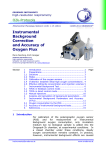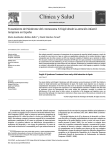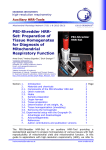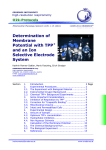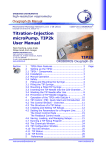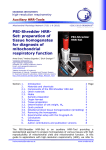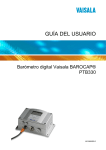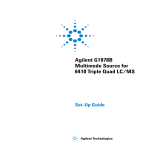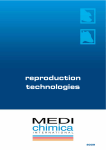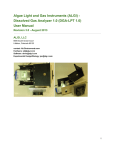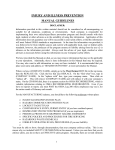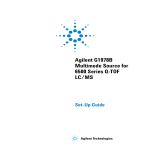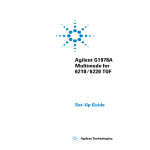Download Instrumental background correction, accuracy of oxygen
Transcript
O2k-SOP Mitochondrial Physiology Network 14.06(03): 1-8 (2014) 2009-2014 OROBOROS O2k-SOP B: www.bioblast.at/index.php/MiPNet14.06_InstrumentalBackground Version 03: 2014-03-06 Instrumental background correction, accuracy of oxygen flux and SOP B Fasching M, Gnaiger E OROBOROS INSTRUMENTS Corp high-resolution respirometry Schöpfstr 18, 6020 Innsbruck Austria Email:[email protected]; www.oroboros.at Section Page 1. Introduction ............................................................................... 1 2. Preparations ............................................................................... 2 2.1 Solutions ............................................................................... 2 2.2 Media .................................................................................... 3 2.3 Calibration of the oxygen sensors ............................................. 3 2.4 Experimental oxygen concentration .......................................... 3 3. Instrumental background test ....................................................... 5 3.1 TIP2k in feedback control mode ................................................ 5 3.2 Manual injections .................................................................... 7 4. Analysis and calculation of background parameters ......................... 8 5. References ................................................................................. 8 Supplement A: Background parameters and accuracy of flux ............... 9 Oxygen consumption by the polarographic oxygen sensor ................... 9 Accuracy of instrumental background tests...................................... 11 Supplement B: TIP2k in direct control mode .................................... 12 1. Introduction For calibration of the polarographic oxygen sensor (POS) and measurement of instrumental background oxygen consumption, incubation medium without biological sample is added into the O2k-Chamber at experimental conditions. In a closed chamber under these conditions, ideally oxygen concentration remains constant. In practice, however, instrumental background effects are caused by backdiffusion into the [email protected] www.oroboros.at MiPNet14.06 Instrumental O2 background 2 chamber at low oxygen pressure, oxygen diffusion out of the chamber at elevated oxygen levels, and oxygen consumption by the polarographic oxygen sensor (OroboPOS). Determination of instrumental background constitutes an important standard operating procedure (SOP) in high-resolution respirometry (HRR). Instrumental background oxygen flux is (i) minimized in the OROBOROS Oxygraph-2k by instrumental design and selection of appropriate materials. In addition, (ii) instrumenal background is routinely tested, and (iii) background correction of oxygen flux is applied automatically by DatLab. As an important component of quality assurance, instrumental background is monitored at regular intervals during an experimental project and documented, as a standard operational procedure to exclude instrumental artefacts. This SOP is implemented even in cases of high experimental oxygen fluxes when background correction is merely within 1%-5% of flux. Taken together, the concept of instrumental background oxygen flux and appropriate corrections are indispensible components of HRR. To obtain accurate parameters for instrumental background correction, background tests are performed in which several oxygen levels are set in the closed O2k-Camber related to the experimental oxygen regime, and background oxygen flux is measured as a function of oxygen concentration. 2. Preparations 2.1 Solutions Dithionite solution (10 mM, in phosphate buffer): Component Final conc. FW Na2S2O4 10 mM 174.1 Phosphate buffer (50 mM, pH 8): Base Acid Final conc. 44 mM 5.9 mM Component Na2HPO4 ∙ 2 H2O NaH2PO4 ∙ H2O Addition to 10 ml final 0.017 g FW 178.0 138.0 Addition to 1 liter final 7.83 g 0.81 g Dithionite solution has to be prepared fresh and stored on ice immediately before use. Add 17 mg dry dithionite into a glass volumetric flask and add phosphate buffer to the final 10 ml volume. Keep the flask closed and minimize exposure to air. OROBOROS INSTRUMENTS O2k-Protocols MiPNet14.06 2.2 Media Instrumental O2 background 3 The dithionite background experiment has to be performed in MiR06 (or MiR05; MiPNet14.13). In many other media (including cell culture media and unbuffered water) side reactions lead to additional oxygen fluxes which interfere with the instrumental background oxygen flux. As an alternative, a strongly buffered alkaline phosphate buffer may be used (>100 mM); >pH 8). Results obtained in MiR06 can be used for other media (e.g. cell culture media). 2.3 Calibration of the oxygen sensors B go Bioblast » MiPNet06.03 POS-Calibration-SOP 2.4 Experimental oxygen concentration Graded levels of oxygen can be achieved in instrumental background tests with the aid of a gas phase included in the O2k-Camber, replacing air with nitrogen or argon (to decrease oxygen levels), or with oxygen (to increase oxygen levels). Mass transfer between gas and liquid phases proceeds until the targeted oxygen level is reached. This process is stopped when the gas phase is eliminated by closing the chamber (Gnaiger et al. 1995; Gnaiger 2008). The main disadvantage of intermittently opening the O2k-Chamber for application of a gas phase during background experiments is the risk of inclusion of gas bubbles when closing the chamber. Elimination of gas bubbles is more difficult in O2k-MultiSensor ISE applications, when one or two additional electrodes are introduced through inlets in the stopper. Importantly, in these applications instrumental background correction is even more important, since inserted electrodes add new oxygen storage capacities and potential leaks. An automatic O2 background test has been introduced to overcome these problems with the TIP2k. Instrumental background tests should cover the entire experimental oxygen range. Most experiments are performed at oxygen levels below air saturation, but high oxygen levels are used with permeabilized fibres. H2O2: With MiR06 (containing catalase) oxygen concentration is easily adjusted by injecting small amounts of a H2O2 stock solution into the closed chamber (MiPNet14.13). OROBOROS INSTRUMENTS O2k-Protocols MiPNet14.06 Instrumental O2 background 4 Oxygen levels are increased in steps of <200 µM (e.g. from air saturation up to 350 µM) to prevent formation of gas bubbles in the medium. 1 O2 (gas phase): For oxygen concentrations above 400 µM, the preferred approach is application of a gas phase with high oxygen pressure. 6 If a calibration at air saturation was just performed, there is already an ‘open chamber’, i.e. a chamber with a gas phase. Insert the stopper, 3 completely closing the chamber. Siphon off any medium extruded through the stopper capillary. Then 2 partially open the stopper (arrow 1), insert the stopper-spacer tool (2) and push down the stopper (3). The gas injection syringe with supplied needle (4; correct length) and spacer (5) is filled with oxygen gas. Inject a few ml 4 of oxygen into the gas phase (6), 5 thereby creating an elevated oxygen pressure above the stirred aqueous medium. Oxygen in the gas and aqueous phases will start rapidly to equilibrate. Observe the oxygen signal in DatLab carefully. When the desired oxygen concentration is nearly reached, close the chamber, thereby extruding the gas phase and stopping the equilibration process. After stabilisation of oxygen flux, the first state of background flux is recorded, by marking an appropriate section of the oxygen flux (MiPNet19.01E). Further steps of oxygen levels towards air saturation may be achieved by shortly opening the stopper (again using the stopper-spacer tool, 2), observing the drop of oxygen concentration and closing the chamber at the desired oxygen level. Preferentially, use the TIP2k method described below. OROBOROS INSTRUMENTS O2k-Protocols MiPNet14.06 Instrumental O2 background 5 3. Instrumental background test 3.1 TIP2k in feedback control mode Fill the TIP2k syringes with the freshly prepared dithionite solution, rinsing the syringes at least once with the dithionite solution and taking care to minimize exposure of the dithionite solution to air. Use a largevolume glass syringe and long needle to fill both TIP2k syringes sequentially. After air calibration close the chamber either directly (normoxia) or after elevating oxygen levels (hyperoxia). After closing the chamber, insert the TIP2k needles through the stopper. TIP2k-Manual: go Bioblast » MiPNet12.10 TIP2k-Manual TIP2k Setup "BG_Feedback": Instrumental background oxygen flux at air saturation (176 µM; 37 °C, 600 m altitude), 90 µM, 45 µM, 20 µM. Each level was maintained for 20 minutes. The following parameters are used in the set up file: Line 1 2 3 4 Mode FB FB FB D Start injection if oxygen level (left chamber) is > µM 120 60 30 OROBOROS INSTRUMENTS Stop injection if oxygen level (left or right chamber is < µM 100 50 23 Flow Delay Interval Volume µl/s 0.5 0.25 0.100 40 s 1200 900 900 s 300 300 300 µl 100 O2k-Protocols B MiPNet14.06 Instrumental O2 background 6 In the DatLab main menu select "TIP", select "BG_Feedback" from the dropdown menu and press "Load setup". Start the titration programme. During operation the TIP2k window may be closed. The TIP2k programme starts, allowing for a delay of 1200 s (20 min), during which time oxygen flux can stabilize after closing the chamber, providing the first background level (J°1). Then the first injection starts at 0.5 µl/s. The TIP2k operates now in feedback mode while oxygen levels decline. The TIP2k stops when an O2 concentration <100 µM is reached, and possibly overshoots by 10 µM to yield a level of about 90 µM (J°2). The 1200 s interval (20 min) is programmed as a feedback control time of 300 s plus a delay of 900 s before each further injection at 0.25 µl/s to 50 µM (J°3) and 0.1 µl/s to 23 µM (J°4) (reducing the overshoot to 5 µM and 3 µM). After recording the last background level (J°4 at 20 µM) a final titration of excess dithionite is induced in the direct control mode for a zero oxygen calibration of the OroboPOS. OROBOROS INSTRUMENTS O2k-Protocols MiPNet14.06 Instrumental O2 background 7 3.2 Manual injections Use a Hamilton syringe for manually injecting the dithionite solution. The effective concentration of dithionite decreases in the stock solution over time due to autoxidation when small amounts of oxygen leak into the solution. The potency of the solution can be tested by injecting a small volume (5 µl) into the closed oxygraph chamber and observing the change in oxygen concentration. The stoichiometric correction factor, SF, expresses the deviation of the effective dithionite concentration from the dithionite concentration added initially, SF SF ΔnO2(eff) ΔnO2(calc) ΔcO2 Vchamber vinject cNa2S2O4 nO2 (eff) cO2 Vchamber nO2 (calc) vinject cNa 2S2O4 (1) Stoichiometric correction factor for dithionite concentration Effective change of the amount of oxygen [µmol] Calculated change of the amount of oxygen [µmol] Effective drop in oxygen concentration [µmol dm-3; µmol.l-1] Chamber volume [cm3; ml] Injected volume of dithionite solution [mm3; µl] Dithionite concentration in the initial stock solution (approx. 9.8 mmol dm-3 considering a complete consumption of oxygen originally dissolved in the aqueous solvent), irrespective of further oxygen uptake by the effectively anoxic solution. vinject is the volume injected to achieve a specific drop in oxygen concentration: vinject cO2 Vchamber SF cNa 2S2O4 (2) A typical value of SF is 0.7 in a freshly prepared stock solution. Since no accurate oxygen concentrations have to be achieved for determination of an instrumental background, a value of 0.7 can be used for most purposes. When using the TIP2k in Feedback Control Mode, calculation of SF is not necessary. OROBOROS INSTRUMENTS O2k-Protocols B MiPNet14.06 Instrumental O2 background 8 4. Analysis of instrumental background tests go Bioblast MiPNet19.01E, MiPNet08.09, MiPNet10.04 Gnaiger 2001 » ; 2008 » ; Gnaiger et al 1995 » 5. References Gnaiger E (2008) Polarographic oxygen sensors, the oxygraph and highresolution respirometry to assess mitochondrial function. In: Mitochondrial Dysfunction in Drug-Induced Toxicity (Dykens JA, Will Y, eds) John Wiley: 327-352. » Gnaiger E (2001) Bioenergetics at low oxygen: dependence of respiration and phosphorylation on oxygen and adenosine diphosphate supply. Respir Physiol 128: 277-297. » Gnaiger E, Steinlechner-Maran R, Méndez G, Eberl T, Margreiter R (1995) Control of mitochondrial and cellular respiration by oxygen. J Bioenerg Biomembr 27: 583-596. » O2k-Manual » MiPNet19.01E » MiPNet12.10 O2 flux analysis: real-time. Titration-Injection microPump. TIP2k user manual. O2k-Protocols » » » » MiPNet06.03 MiPNet08.09 MiPNet10.04 MiPNet14.13 POS calibration, accuracy and quality control SOP. HRR with leukemia cells: respiratory control and coupling. HRR: Phosphorylation control in cell respiration. Mitochondrial respiration medium – MiR06. Full version: go Bioblast » MiPNet14.06 InstrumentalBackground OROBOROS INSTRUMENTS O2k-Protocols MiPNet14.06 Instrumental O2 background 9 Supplement A: Background parameters and accuracy of flux Oxygen consumption by the polarographic oxygen sensor The Clark-type polarographic oxygen sensor (POS) yields an electrical signal while consuming the oxygen which diffuses across the oxygenpermeable membrane to the cathode. The cathode and anode reactions are, respectively, O2 + 2 H2O + 4 e4 Ag 4 Ag+ + 4 Cl- 4 OH 4 Ag+ + 4 e 4 AgCl (3a) (3b) (3b’) The electric flow (current, Iel [A]) is converted into a voltage (electric potential, Vel [V]) and amplified. In the Oxygraph-2k the gain, FO2,G, can be selected in DatLab within the Oxygraph setup menu, with values of 1, 2, 4, or 8106 V/A, where 1 V/µA is the basal gain at a gain setting of 1. The raw signal after amplification, RO2 [V], is related to the original POS current, Iel = RO2 FO2,G-1 (4) Flux, J°O2 [pmol.s-1.ml-1] Figure 2. Instrumental background oxygen flux, J°O2, as a function of oxygen 2 concentration, cO2 [µM], in the OROBOROS Oxygraph-2k (37 1 °C; NaCl solution with an oxygen solubility factor of 0 0.92 relative to pure water). Measurements in 52 -1 chambers (2 ml volume) of 26 different instruments. In all -2 tests, four oxygen ranges were selected consecutively in 0 50 100 150 200 declining order. Each oxygen Oxygen concentration [µM] concentration was maintained for 20 min, at the end of which, time intervals of 200 seconds (corresponidng to 200 data points at the sampling interval of 1 s) were chosen for estimating average flux at each corresponding oxygen concentration. Averages and SD were calculated for the intercept, a°, and the slope, b°, by linear regression for each individual chamber. The full and stippled lines show the linear regression and 99 % confidence intervals calculated through all data points. 3 a° = -2.06 0.39 b° = 0.0256 0.0028 r ² = 0.93 N = 52 RO2 is about 9 V (at air saturation, 37 °C, and a gain of 4106 V/A), and is thus typically 2.2 µA under these conditions. In the cathode reaction (Eq. 3a), electric flow, Iel [A=Cs-1], is stoichiometrically related to molar oxygen flow, IO2 [mol O2s-1], through the stoichiometric charge number of the reaction, e-/O2 = 4, and the Faraday constant, F, i.e. the product of the elementary charge and the Avogadro constant (F = 96,485.53 Cmol-1; Mills et al., 1993). The oxygen/electric flow ratio is (Gnaiger, 1983), OROBOROS INSTRUMENTS O2k-Protocols B MiPNet14.06 Instrumental O2 background 10 YO2/e- = (e-/O2 F)-1 = (4 96,485)-1 molC-1 = 2.59106810-6 mol O2C-1 = 2.591 pmol O2s-1µA-1. (5) Oxygen consumption by the POS can be directly measured in the closed Oxygraph chamber at air saturation (Fig. 2), as volume-specific oxygen flux, JO2° [pmols1cm3], and the corresponding theoretical oxygen flux in Eq.(3a) can be calculated, JO2,POS (Fig. 3), JO2,POS = (RO2 - RO2,0) YO2/e- FO2,G-1 V-1 (6a) where RO2,0 is the raw signal at zero oxygen (zero current), and V is the chamber volume of the Oxygraph-2k (2 cm3). Flux, J°O2 [pmol.s-1.ml-1] Figure 3. Instrumental background oxygen flux, J°O2, 3 as a function of the theoretical ity t n 2 oxygen consumption by the f ide o polarogrpahic oxygen sensor Line 1 (POS), calculated from the electrical signal (current) as a 0 function of oxygen concentration (from data in -1 Figure 1). The line of identity (dashed) illustrates the full -2 correspondence between experimental and theoretical 0 1 2 3 oxygen consumption at air -1 -1 Expected POS flux, J°O2,POS [pmol.s .ml ] saturation (top right) and the increasing deviation at declining oxygen concentration owing to a linear increase of oxygen backdiffusion. It is more convenient to relate the theoretical oxygen consumption of the POS to the measured oxygen concentration, cO2 [µM], using the oxygen calibration factor, FO2,c [µM/V], JO2,POS = (cO2 FO2,c-1) YO2/e- FO2,G-1 V-1 (6b) Combining constants from Eq. 5, at a gain setting of 4 V/µA and a volume of 2 cm3, Eq. 6 is, JO2,POS = (RO2 - RO2,0) 0.3239 pmols-1cm-3V-1 = cO2 FO2,c-1 0.3239 pmols-1cm-3V-1 (6c) Figure 4. Noise (SD of the mean) of the apparent oxygen flux, J’O2, as a function of noise (SD of the mean) of oxygen concentration, cO2 (180 2 µM; at 95 1 kPa barometric pressure), in the “open” chamber of the OROBOROS Oxygraph2k (37 °C; NaCl solution, at air saturation), over time intervals of 200 seconds (corresponidng to 200 data points at the sampling interval of 1 s). Each data point (N=43) represents an independent Oxygraph-2k chamber (2 ml volume). The SD of oxygen concentration was calculated from the raw signal without smoothing. Flux was calculated from concentration smoothed with a moving average (30 data points), using an eight point polynomial for calculation of the slope. The outlier (full circle) corresponds to a data set with an individual spike. OROBOROS INSTRUMENTS O2k-Protocols MiPNet14.06 Instrumental O2 background 11 SD of flux, J´O2 [pmol.s-1.ml-1] The full and stippled lines show the linear regression Air saturation (open) and 99 % confidence 1.0 intervals. On average, signal stability was indicated by 0.8 apparent oxygen fluxes close to zero during air calibration, 0.6 when oxygen concentration is maintained stable by 0.4 exchange with the gas phase. 0.2 Average J’O2 amounted to 0.04 0.14 pmols-1cm-3 0.0 (range from –0.28 to 0.25 -1 -3 To express 0.00 0.01 0.02 0.03 0.04 0.05 0.06 0.07 pmols cm ). signal noise independent of SD of oxygen concentration [µM] these low levels of signal drift, linear regressions were calculated through these 200 second sections, and this drift was subtracted from the concentration before calculating the SD. 1.2 SD of flux, J°O2 [pmol.s-1.ml-1] Figure 5. Noise (SD of the mean) of the instrumental Intercept; SD(0) = 0.024 background oxygen flux, Slope = 0.0031 0.75 J°O2, as a function of oxygen concentration, cO2 [µM], in the OROBOROS 0.50 Oxygraph-2k (37 °C; NaCl solution), over time intervals of 200 seconds 0.25 (corresponidng to 200 data points at the sampling interval of 1 s). Each data 0.00 point (N=43) represents an 0 50 100 150 200 independent Oxygraph-2k chamber (2 ml volume). Oxygen concentration [µM] Flux was calculated from concentration smoothed with a moving average (30 data points), using an eight point polynomial for calculation of the slope. The full and stippled lines show the linear regression and 99 % confidence intervals. To express noise of flux independent of small changes in flux over time, linear regressions were calculated through 200 second sections, and this trend was subtracted from flux before calculating the SD. 1.00 Accuracy of instrumental background tests Instrumental background interferes with accurate measurement of respiratory oxygen flux, if background effects remain undefined. The instrumental oxygen background parameters are a property of the O2kChamber. Any contamination of the medium causing oxidative processes (microbial respiration) is detected. Then background oxygen consumption is a property of a contaminated medium. Otherwise instrumental background does not depend on the specific medium. Therefore, OROBOROS INSTRUMENTS O2k-Protocols B MiPNet14.06 Instrumental O2 background 12 background parameters obtained in one medium can be used for another medium in the same chamber. In a series of 52 experimental background determinations, 52 different O2k-chambers (2 ml volume, 37 °C) were tested (Oxygraph-2k, Series A). The following average conditions applied: Oxygen concentration at air saturation, cO2* = 179.9 µM Average oxygen concentration at J°1, cO2,1 = 177.2 µM Oxygen calibration signal at air saturation, RO2,1 = 8.744 V (Gain 4) Oxygen calibration signal at zero oxygen, RO2,0 = 0.033 V (Gain 4) Oxygen calibration factor, FO2,c = 20.69 µM/V JO2,POS = 0.3239 x 177.2/20.69 = 2.77 pmols-1cm-3 At air saturation in the 2 cm3 chamber, the theoretically expected oxygen consumption by the sensor is 2.77 pmols-1cm-3, in direct agreement with the experimental result. At an average flux of 2.64 pmols-1cm-3 (0.35 SD; N=52; Fig. A2), the ratio between measured and theoretically expected oxygen consumption by the POS was 0.95 (0.12 SD; N=52). This provides possibly the first experimental evidence for the exact 4electron stoichiometry in the reduction of oxygen at the cathode of the POS. Supplement B: TIP2k in direct control mode TIP2k-Manual go Bioblast » MiPNet12.10 TIP2k-Manual Fill the TIP2k syringes with freshly prepared dithionite solution. After air calibration record the first point of the background experiment as described above. Programming the TIP2k: Calculate the necessary injection volumes as described in Section 2.5, initially assuming SF = 0.7 (stoichiometric correction factor for dithionite concentration). SF can be calculated after the first injection and – if necessary – the TIP2k be reprogrammed for subsequent injections. Alternatively, SF may be determined initially: Set the Volue, vinject, to 5 µl; Test start before inserting the needles, to replace the dithionite solution in the needles; Wait for stabilisation of oxygen flux; Inject 5 µl and calculate SF using Eq.(1). Example: Oxygen level in the chamber is 160 µM. The user wants to obtain four background levels (in addition to the one recorded near air saturation). With four evenly OROBOROS INSTRUMENTS O2k-Protocols MiPNet14.06 Instrumental O2 background 13 spaced steps it is possible to reach a minimum of 20 µM reducing the oxygen concentration by 35 µM steps. The necessary injection volume, vinject, to achieve the desired reduction of oxygen concentration can then be calculated from Eq.(2). In the present example: SF = 0.7; ΔcO2 = 35 µM; Vchamber = 2 ml; cNa2S2O4 = 9.8 mM vinject = 10 µl Four injections of 10 µl each should therefore bring the oxygen concentration near the desired last level of 20 µM. Optionally, with a fifth injection, zero oxygen concentration could be reached. It is recommended to use a larger excess volume for zero calibration. Always consider the expected experimental oxygen concentration range: For an experiment at high oxygen levels, calculate injection to decrease from the initial oxygen level (e.g. 350 µM) to the final oxygen concentration (e.g. air saturation). The minimum time required between injections to obtain stable fluxes is about 10 minutes. The time course of the instrumental background should match the decline of oxygen concentration in the real experiment. Longer intervals will typically be chosen (15 min in our example). The TIP2k can be set up in the following way: Select Direct control and Vol+Flow Delay [s] 0 Volume [µl] 10 Flow [µl/sec] 30 Interval [s] 900 Cycles 4 Start the experiment with Start. OROBOROS INSTRUMENTS O2k-Protocols B













